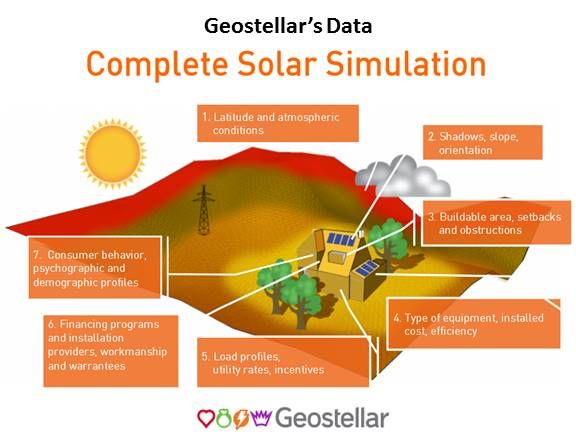Residential solar customers can now do their shopping online through an interactive consumer-facing website and a new smartphone app.
“Our goal is to provide solar buyers with a multi-sided platform,” said Geostellar CEO David Levine. He wants the company to be the KAYAK of rooftop solar and provide every U.S. homeowner access to a real-time, free, and independent cost-benefit assessment of their solar purchase options.
Geostellar’s website and its Solar Mojo iPhone app (an Android app is being developed) are based on the company’s ability to conduct rooftop analyses with 1-meter resolution powered by “big-data geomatics,” according to Levine.
The interfaces then draw on inventories from the biggest solar equipment distributors, including Conergy and Sonepar, to suggest the best equipment and price for the specific address entered. They also match solar panels from the major manufacturers, including Trina, Yingli, SunPower, and others, with that address’s rooftop.
Geostellar also offers a selection of qualified solar installers that can include majors, like SolarCity, Real Goods, Astrum, Roof Diagnostics, and Verengo, as well as local independents.

Using data from the involved utility, local usage patterns, and details like the address’s shading, slope and orientation, the interfaces estimate a “typical” monthly utility bill and model the homeowner’s expected savings from going solar either through a cash investment, bank loan, or a lease or power purchase agreement. Calculations include local interest rates, rebates and incentives.
Projected savings are based on Geostellar’s 25-year utility price estimates that incorporate historical utility price data since 2001 obtained from the U.S. Energy Information Administration.
Final lease and PPA calculations draw on zero-down cost formulas from NRG Residential Solar Solutions, SolarCity, and Clean Power Finance. Final loan calculations draw on Admirals Bank’s national solar loan program and assume a standard twenty-year term. Geostellar’s interfaces adjust the down payment if the cost of the system exceeds $40,000 and recalculates if the customer opts for a shorter-term loan.
The interfaces also estimate emissions savings from going solar at the submitted address based on the local utility’s energy mix.
Websites like Energy Sage and Grid Bid are somewhat competitive in the same space, Levine said. “But they and others are really just lead generators. When we’re done, we hope to be the single solar search site, the Google of solar marketplaces.”

Geostellar earns transaction fees of “a couple of thousand dollars per system sold” from installers and finance companies, Levine said. The marketplace’s first dozen projects are completed, Levine added, and “a pipeline of a few hundred are coming up.”
The quoted installed price range in the Geostellar marketplace was initially between $3.50 per watt and $4.25 per watt but increased competition is driving installers toward the $3.50 price, Levine said.
Downward price pressure came from agreements with the major installers and with the distributor-recommended independent local installers, Levine said. “If local variables like solar resource or labor cost require a higher price, it can be done. But we are creating a lower market price by forcing installers toward the $3.50 price.”
The Geostellar portal makes a few basic assumptions, some of which are provided to the user. “We are constantly struggling with how to organize the numbers [accurately]. We think we have exposed every relevant detail.”
Geostellar started up in February 2010 as a provider of solar analyses to developers like Sunrun, Sungevity, and SunPower, Levine said. “In March 2012, we raised $14 million to develop our own marketplace. The lead investor was NRG Energy. The satellite company DigitalGlobe, which provides some of our data, and Flash Forward Investors also backed us, along with about 30 angel investors from the cleantech sector.”
Through 2013, Geostellar’s 1-meter-resolution database incorporated 57,237,631 properties, covering 887,154 square kilometers in 542 counties. “That covers most of the major solar markets in California and the West, plus parts of New England and the Midwest,” Levine reported. “We will continue to acquire 3-D surface data and support data one county at a time.”
The next four next steps for Geostellar, Levine said, will come in 2014:
- A recent $750,000 DOE grant will be used to publish an application programming interface to allow platform innovations
- Crowdfunding will soon be available through Solar Mosaic
- Commercial project information, such as rates and incentives, will be incorporated to allow larger installations
- Brand identity will be developed, first by creating the Geostellar brand, then adding solar offerings through established brands like AAA, AARP, or Mileage Plus, and, ultimately, by introducing solar buyers to panel, installer, equipment, and financier brands



